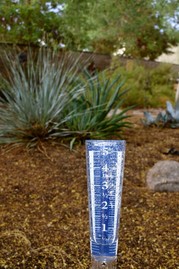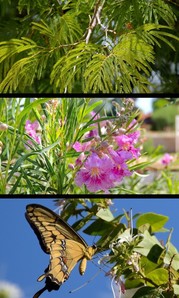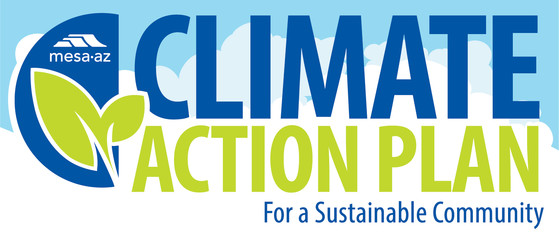
We were hoping for significant rain by now, but the boost in moisture from Tropical Storm Enrique got lassoed by New Mexico. Forecasts have now been reduced to a 20-30% chance for the next few days, but thankfully higher elevations across the state have received some much needed rain.
Since monsoon storms can be localized, shop for a rain gauge if you don't have one, or empty the dust out if you do. If you get at least 1/2" of rain, turn your irrigation off. See our tips below to learn about grass removal and rainwater harvesting - both will save you water and money!
Recommendations below are for plants that are established in the landscape (in the ground about two years).
|
- Desert Adapted - once every 14 days
- High Water Use - once every 7 days
- Desert Adapted - once every 16 days
- High Water Use - once every 8 days
- Desert Adapted - once every 12 days
- High Water Use - once every 5 days
Cacti and succulent watering
Annuals & vegetable watering
Note: These recommendations are a general guideline only and may need to be modified for your specific site conditions.
Landscape Watering by the Numbers: Don’t forget our online, interactive watering guide. If you input some simple information about your landscape irrigation system, it will tell you how long to water to give your plants just the right amount with these frequencies.

Plants to Provide Shade, Color, and Wildlife
July Sustainability Savings Tip: Desert Plants Are Great at Multi-Tasking. By selecting plants that are well adapted to our desert climate you’ll have less maintenance and more time and money while enjoying a more attractive landscape. Learn more.
August 18 from 12-1 p.m. Zoom Workshop! Join us as we share beautiful plant ideas for your landscape. This Mesa Red Mountain Library lunchtime program features Environmental & Sustainability staff who will share plant selection ideas to attract birds or butterflies, provide year-round color, or help to create a cool, shady retreat. Don’t worry, these are low-water using plants that are easy to maintain, too. Learn more and register.
Did you miss our June class on Secrets of Summer Watering and Maintenance? A video of the talk and resources mentioned can be found here.
|
Rainwater Harvesting

Don’t miss out on using this clean, salt-free source of water that contains many beneficial ingredients for plants. Check out our resources below for harvesting rainwater from our monsoon storms:
- Visit our Water Harvesting page: Whether you want to naturally channel rainwater to your plants or use a barrel or cistern for storage, we’ve collected all of the best local resources for you.
- Rain amounts vary greatly across the Valley. So, if you are not sure how much fell in your yard (and you didn't buy a rain gauge yet), visit rainlog.org or Maricopa County Flood Control Rainfall Map. As mentioned above, if you get at least 1/2" of rain you can skip an irrigation cycle.
|

SRP Shade Tree Workshops
SRP offers a Shade Tree Workshop, then gives you 2 free trees to plant on your property to help save energy. The next ONLINE class options will be offered on July 31, Aug. 21 and Sept. 8 via Zoom. Since summer isn't the best time to plant, there will be a pick-up planned for fall. For SRP electric customers only. Register here.
Photo: Desert Willow
|

High Water Bills?
Well, if you have a pool, over 2,500 gallons just evaporated! Learn more below. Our Know Your H2O Water Calculator is a great tool to help you determine how much water you should be using. After going through the estimates, you can request a free water-saving kit with a low-flow WaterSense showerhead, outdoor hose nozzle, and more that will help you save water! If your water use is a lot higher than it should be, check out our High Water Use Action Plan document and our Find and Fix Leaks guide.
|

It's Swimming Pool Season
|

How long should you run your irrigation?
Each time you water, be sure to water deeply. About 1 foot for groundcover, 2 feet for shrubs and 3 feet for trees. How long is that? See our interactive landscape watering guide for a quick and easy way to determine your run times. For example, a 2-foot diameter shrub would need about 4 gallons of water each time you water. If you have a 1-gallon per hour emitter on that shrub, your run time would be 4 hours!
|
 Other timely tips:
- July is SMART Irrigation month. Learn how to fix common irrigation problems on our Water – Use It Wisely blog.
- Some of my favorite monsoon resources:
Climate Action Plan
Approved on June 21, Mesa has formed its first Climate Action Plan. This Mayor and Council priority initiative sets targets and will help establish policy to reduce greenhouse gas emissions, build resilience in our community, and to address the negative outcomes of a changing climate. Read the plan, and stay informed by exploring the data.
Listen to an interview with Mayor Giles on KJZZ - The Show.

**Reduce your landscape water use 30 to 50 percent by adjusting your irrigation each season.** Landscape Watering by the Numbers: A Guide for the Arizona Desert will help you determine how much water to apply and how long to run your system. Visit the interactive website.
-H2O-
|